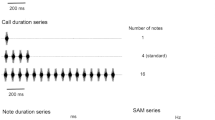Summary
Unit discharges associated with ultrasonic vocalization were recorded from the rat medullary region including the nucleus ambiguous (NA). Three types of units were distinguished: ultrasound-related (US), expiration (EXP) and inspiration (INSP) units. Both US and EXP units discharged with tonic bursts mostly prior to ultrasounds. US units were silent during respiration while EXP units discharged synchronously with expiration. During ultrasonic vocalization INSP units suppressed their discharges which were otherwise synchronized with inspiration.
Histological examination revealed that US and EXP units were recorded from the ventral division of the NA and the adjacent medullary region where the NA contained large cells and the adjacent region consisted of small cells.
These results suggest that both US and EXP units are NA motoneurons responsible for ultrasound emission. EXP units were always supplied with respiratory afferents while US units were not.
Similar content being viewed by others
References
Bertrand F, Hugelin A (1971) Respiratory synchronizing function of nucleus parabrachialis medialis: Pneumotaxic mechanisms. J Neurophysiol 34: 189–207
Gisbergen JAM, Robinson DA, Bielen S (1981) A quantitative analysis of generation of saccadic eye movements by burst neurons. J Neurophysiol 45: 417–442
Green JH, Neil E (1955) The respiratory function of the laryngeal muscles. J Physiol (Lond) 129: 134–141
Fifková E, Maršala J (1965) Stereotaxic atlases for the cat, rabbit and rat. In: Bŭres J, Petrah M, Zachar J (eds) Electrophysiological methods in biological research. Academic Press, New York, pp 653–731
Hinrichsen CFL, Ryan AT (1981) Localization of laryngeal motoneurons in the rat: Morphological evidence for dual innervation? Exp Neurol 74: 341–355
Kalia MP (1981) Neurohistochemical methods in tracing central respiratory mechanisms. Fed Proc 40: 2365–2371
Lemere F (1932) Innervation of the larynx. I. Innervation of laryngeal muscles. Am J Anat 51: 417–437
Lipski J, Merrill EG (1980) Electrophysiological demonstration of the projection from expiratory neurons in the rostral medulla to contralateral dorsal respiratory group. Brain Res 197: 521–524
Lore R, Flannely K (1977) Rat societies. Sci Am 236: 106–116
Luschei ES, Fuchs AF (1972) Activity of brain stem neurons during eye movements of alert monkeys. J Neurophysiol 35: 445–461
Merrill EG (1970) The lateral respiratory neurones of the medulla: Their associations with nucleus ambiguus, nucleus retroambigualis, the spinal accessory nucleus and the spinal cord. Brain Res 24: 11–28
Merrill EG (1981) Where are the real respiratory neurons? Fed Proc 40: 2389–2394
Murray JG (1957) Innervation of the intrinsic muscles of the cat's laryngeal nerve: A unimodal nerve. J Physiol (Lond) 135: 206–212
Nakamura F, Uyeda Y, Sonoda Y (1958) Electromyographic study on respiratory movements of the intrinsic laryngeal muscles. Laryngoscope 68: 109–119
Nosaka S, Kamaike T, Yasunaga K (1978) Central vagal organization in rats: An electrophysiological study. Exp Neurol 60: 405–419
Roberts LH (1975) Evidence for the laryngeal source of ultrasonic and audible cries of rodents. J Zool (Lond) 175: 243–257
Schweizer H, Ruebsamen R, Ruehle C (1981) Localization of brain stem motoneurons innervating the laryngeal muscles in the rufous horseshoe bat, Rhinolophus rouxi. Brain Res 230: 41–50
Suga N, Schlegel P, Shimozawa T, Simmon J (1973) Orientation sound evoked from echolocating bats by electrical stimulation of the brain. J Acoust Soc Am 54: 793–797
Suthers RA, Fattu JM (1973) Mechanisms of sound production by echolocating bats. Am Zool 13: 1215–1226
Wetzel DM, Kelley DB, Campbell BA (1980) Central control of ultrasonic vocalization in neonatal rats. I. Brain stem motor nuclei. J Comp Physiol Psychol 94: 596–605
Yajima Y, Hayashi Y, Yoshii N (1980) The midbrain central gray substance as a highly sensitive neural structure for the production of ultrasonic vocalization in the rat. Brain Res 198: 446–452
Yajima Y, Hayashi Y, Yoshii N (1981) Identification of ultrasonic vocalization substrates determined by electrical stimulation applied to the medulla oblongata in the rat. Brain Res 229: 353–362
Yajima Y, Hayashi Y, Yoshii N (1982) Ambiguous motoneurons discharging closely associated with ultrasonic vocalization in rats. Brain Res 238: 445–450
Author information
Authors and Affiliations
Additional information
Dedicated to Dr. Kitsuya Iwama, emeritus Professor of Osaka University Medical School, on his retirement
Rights and permissions
About this article
Cite this article
Yajima, Y., Hayashi, Y. Ambiguous motoneurons discharging synchronously with ultrasonic vocalization in rats. Exp Brain Res 50, 359–366 (1983). https://doi.org/10.1007/BF00239201
Received:
Issue Date:
DOI: https://doi.org/10.1007/BF00239201




